THE IMPORTANCE OF SET-UP
San Francisco's One Union Recording Studios (www.oneunionrecording.com), which primarily serves commercial, episodic television and feature film markets, has recorded voices for a number of animated features, including Pixar's Monsters Inc., Toy Story 2 and A Bug's Life. The company has also worked on several animated films now in production.
"Recording voices for animation is not unlike live theater or live music: you only get one take," says president John McGleenan. "If you've got someone like Robin Williams and their performance is spectacular and perfect, you can't ask them to do it again. You can do other VO work, narration and ADR until you get it right, but you only get one shot at this." Since nailing the recording the first time is essential, set up time is usually longer and more painstaking "so we can protect ourselves and catch everything," he notes.
While One Union Recording boasts five studios, Studio 3, a 5.1 surround suite with a Euphonix System 5 console, is most often used for recording voices for animation. "We had done animated features in other rooms prior to our expansion, but we built Studio 3 with animation in mind," McGleenan explains. "We put in a full-length window between the vocal booth and control room so we can see the talent from head-to-toe. The camera captures the whole person and we're able to ride the mic better because we're getting a complete view of the actor and how they're acting; you can see and feel the emotion as they talk."
Typically, storyboards and models of the character to be voiced are available at this stage. A private lounge is adjacent to the large iso booth where the talent can sit with the director, "away from everybody else and become the character," says McGleenan.
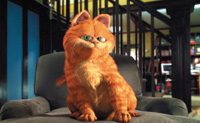
Sound One hosted Bill Murray, the voice of Garfield, for ADR work.
|
A large complement of mics, including Neumann U87s and 149 tubes, lavaliers and Sennheisers, is available. "We usually run with two U87s as benchmarks," McGleenan says, although the studio can easily provide most mics of choice. The talent is well covered, recording into the camera, Pro Tools|HD and several simultaneous DATs locked to timecode.
The Euphonix System 5 allows McGleenan to create multiple monitor stems so the level and tonality in the talent's headphones, for example, can be different from that in the director's headphones and in the room. "Although you just capture one channel of sound for animation, the Euphonix enables us to route the same signal path with different decibel levels so if one is overmodulated, we're protected with another," he adds. "The Euphonix routing matrix also permits me to change a set-up in milliseconds instead of minutes."
McGleenan and his colleagues enjoy "being part of the process" when an animated feature just begins taking its baby steps. "We're doing work today that won't be on film until 2007," he points out. "I'm constantly amazed when I see the finished product. You paint a picture of what the character is like when you do the voice recording, but when you see the animation on the big screen, it blows you away."
SOUNDS LIKE LIVE ACTION
Animation powerhouse Nelvana (www.nelvana.com/) handles post production for much of its product in its 14-month-old Toronto facility. On the audio post side it boasts a multi-purpose record suite and two mix theaters with Pro Tools|HD 3 systems with Accel cards running 6.2.3 on the latest Macintosh OS X 10.3.4 workstations. The Pro Tools systems have ProControl surfaces with fader and edit packs. An 8 TB SAN solution links the audio engineers to video editors who cut shows on eight Final Cut Pro systems in 16:9 anamorphic. All mixing is done in 5.1, optimized for broadcast. The 5.1 mixes prepare shows for DVD release and future-proofs them for further distribution.
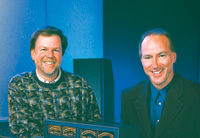
Advantage Audio partners Bill Koepnick and Jim Hodson (L-R): their long list of animated credits includes Dave the Barbarian.
|
Among the current workflow in-house at Nelvana are the 2D-animated Jacob Two-Two, which airs on YTV in Canada, and the 3D-animated Miss Spider's Sunny Patch Friends and The Backyardigans which are both about to make their fall debuts on Nick Jr.
Senior post audio supervisor Ryan Araki believes the proliferation of 3D animation on TV has prompted the trend to more cinematic audio post. "When you watch a Pixar movie with such detail - the grass moves, the clothing moves - it's like live action, and you want to hear that. The same for 3D on television. You have to cover that detail. It's different from the days of George Jetson's shirt that never budged."
Araki also notes that animation lacks the "live facial expressions of actors to cue the audience to what to listen to" so audio has to step in to fill that role. "Every sound is there for a purpose," he emphasizes. "It provides support for the story."
For the past 18 months or so, Araki has noticed a demand for sound effects and music cues in the pre-production stage. "Animators can receive sound files and integrate them into their Flash programs and animate over them," he explains. "It helps them get the job done faster, and the director gets exactly what he wants. It also gains time on the post end: about 70 percent of the time those cues work and remain in the finished product."
While animated shows have always featured atmosphere when dialogue or sound effects did not take center stage, Araki has lately seen series call for more detailed backgrounds and environments, including Miss Spider's Sunny Patch Friends, whose all-insect cast lives around a giant tree. "This show has a very rich atmosphere, deep textures and very organic sounds," he says. "The animation process allows us to have a large amount of creative input, which gives us the opportunity to provide unique and interesting soundtracks."
GETTING IN SYNC
"The common perception is if you can do sound effects for animation, you can do it for anything," says Glenn Oyabe, sound effects supervisor at Burbank's Glenwood Editorial (818-569-3636). "A live-action series like Friends is more of a Foley-driven show whereas an animated series must not only re-create those natural elements but also add cartoony sound effects, supernatural ambiances and more. An animated show might have someone flying out the window and hitting 12 things on the way down to the trash can, a meteor crash, an undersea environment. People say sound effects for animation is the toughest thing to do."
Glenwood has extensive animation credits. Well known for animation prepro, the company's track reading for 10 seasons of The Simpsons, King of the Hill and various Klasky Csupo programs helps lipsync artists keep words and mouth movements in sync.
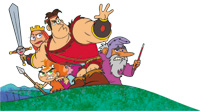
Dave the Barbarian.
|
On the audio post side Oyabe handles sound editing for The Grim Adventures of Billy & Mandy, now in its third season, airing in primetime on Cartoon Network; What's New Scooby Do?, in its third season on Kids WB; and, for the past two years, Johnny Bravo on Cartoon Network. He also did music editing for the early seasons of The Powerpuff Girls. Glenwood sound editor Jason Freedman recently wrapped the run of the urban superhero series Static Shock for Kids WB and will start this fall on the new WB toon Krypto, which is about Superman's dog. He has also sound designed Ozzie and Drix and the Cartoon Network series Time Squad.
With TV animation budgets shrinking and schedules tightening, the bottom line often threatens to take precedent over sound quality, Oyabe laments. "Guys with DAWs at home can low ball a project just to get it in the door but may not have the animation experience to deliver just what the producer needs," he says. "Our sound editors work hard all hours to get shows to sound exactly as they should."
Oyabe sees the line between animation and live-action sound effects starting to blur. "Producers want live-action sounds, not cartoony sounds, even in all-animated product," he observes. For The Grim Adventures of Billy & Mandy, he pulls sounds "from all over. The producer, who created the series, is such a creative guy that you never know what you'll find in an episode. When they spoof a movie we try to tie sound effects from that movie into the show: they did an episode with alien chickens, so we featured available sounds from Aliens 3 [provided by the movie's sound editor], which I had altered and mixed with other organic sounds."
Kids WB animation tends to be "very music driven," says Oyabe. "The composers have to capture the flavor of the show, but sound effects often has a cleanslate." By contrast, What's New, Scooby Do? often references sound effects from the venerable Scooby Do franchise "so if you were to hear the audio without seeing the visuals, you could still identify it."
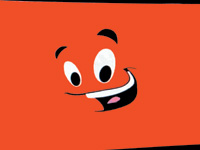
Face.
|
Oyabe creates his soundscapes working to picture with a Pro Tools system and "tons" of sound effects libraries. "Every time an editor comes through, we trade sound libraries so our collection keeps increasing," he reports. "We can also go out and record custom sounds if a project calls for it. Five or six years ago animation budgets were large enough that shows had a sound effects supervisor, sound editor, someone to record and edit Foley and edit backgrounds. Now, in a lot of companies, one guy has to do all of that."
HOME-BASED PIRATE POST
Peter Cole offers guerrilla independent-style audio post for animation at Pirate Post (www.piratepost.net/), his full-fledged, home-based facility in Studio City, CA. Cole has a number of primetime animation credits, including a season of The Simpsons (which he did at Skywalker Sound) and two seasons of Will Vinton's The PJs; he mixed all but the last season of Futurama. Pirate Post handled all the re-recording mixing, additional editing and sound design, via Chris Trent, for the Comedy Central series Kid Notorious, which aired last fall.
"Animation requires a different sensibility from live action," says Cole. "Dialogue is king with animation: it's all about the joke, which is usually not the case with episodic. The background levels tend to be very subtle in animation because of a concern that the jokes not be lost. The PJs was a departure because I was able to play up the inner-city sounds a bit. It was a more episodic style of mixing backgrounds."
Kid Notorious portrayed the real-life and fictional adventures of movie icon Robert Evans as he charmed Hollywood, battled global corruption and always got the ladies. Evans voiced his own character.
"The producers thought the show might go to DVD so we mixed the whole project in 5.1, even though we delivered in stereo to the network," notes Cole. "People say it doesn't take much longer to mix in 5.1, but it took a considerable amount of time. With the animation, we were moving things around and experimenting with changing perspectives on screen: a voice could come from offside or behind you instead of the center. And we could place interesting things in the background to help sell the story."
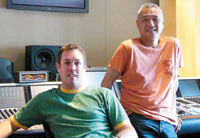
Tonic's Jody Nazzaro and Jun Mizumachi (L-R) gave voice to "Face," who appears in interstitials on Nick Jr.
|
He calls the combination of Pro Tools and animation awesome. "With Pro Tools I had the ability to get in and do intricate moves on the sound effects. I had a field day with the level of automation. It still amazed me that I can have about 100 tracks of sound on one computer in a 5.1 environment and I can do anything I could do on a dub stage and more."
Dialogue and video editor Paul Calder provided Cole with dialogue OMFs. "Robert Evans has a bass voice, a very full voice, and it was a challenge to bring some clarity to it and make it sit with everybody else," Cole recalls. He deployed a Sony Oxford EQ and Waves plug-ins for compression to achieve the desired balance.
Chris Trent, a Foley mixer, sound editor and designer, and longtime Cole collaborator, did extensive Foley work for Kid Notorious. "The newer animated shows don't pull Hanna-Barbera effects or other classic funny sounds," he says. "They're not a whole lot different from regular episodic television apart from being larger than life, and bigger is funnier."
Using Pro Tools, Sample Cell and a Neumann U87 mic in his home studio, Trent crafted full Foley and cloth tracks, padding around in socks on different surfaces for the sound of cat paws and stomping on ice for a scene in the Himalayas. Trent predubbed many effects for Cole "so Peter could concentrate on the nuances of mixing." Cole calls Trent "a very good mixer in his own right" and acknowledges that Trent "made a lot of mixing decisions in the way he built things that saved me time."
GIVING 'FACE' A VOICE
"Face," the childlike animated character who stars in interstitials for Nickelodeon's Nick Jr. programming block, is a collection of facial features (eyebrows, eyes, a black-line mouth) that can transform itself into various objects - a bouncing ball, the sun, a flower - while his features grin, look surprised and appear delighted.
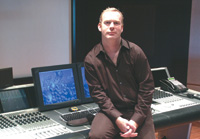
One Union's John McGleenan, leaning on the System 5, likens voice recording for animation to that of live theatre: "You only get one shot," he says.
|
Face's recent redesign called for several months of new voice recording, editing, sound design and mixing at New York City's Tonic (www.tonic.tv/). In an iso booth attached to Studio B, audio engineer/mixer Jody Nazzaro used a Neumann U87A mic with Avalon 2022 mic pre to record voiceover talent at 24-bit/48kHz into Pro Tools with a Euphonix System 5 console.
"I love animation because 100 percent of the sound is studio recorded," says Nazzaro. "It's the most pristine-quality audio we can create and work with. And with animation, the sky's the limit! It's the most fun to work on."
Nazzaro edited the VO to pacings specified by Nickelodeon producer Morgan Russo; the interstitials are of different lengths and can be as short as five seconds. He prepared a CD of VO edit files for Russo to present to the animators who created Face's look and very mobile facial features.
Then Tonic sound designer Jun Mizumachi was charged with creating custom sound effects to enhance the various guises of Face. "It was a challenge," he says. "The sound of Face has to be very simple and minimalistic, but he changes into different colors, shapes and objects. There are no sounds pre-made for this. Morgan didn't want cliche sounds from an effects library; she wanted me to come up with some new textures and passages."
Because the audience for Nick Jr. consists of pre-schoolers, Mizumachi's sound effects couldn't be too big, abstract or dark. Nor could they sound like conventional cartoon effects. Working to almost final animations, Mizumachi sat down at his Synclavier to craft sounds for Face's world.
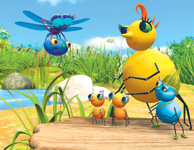
Nelvana gives Miss Spider's Sunny Patch Friends detailed backgrounds and environments via organic sounds.
|
He devised chord progressions and glissandos of different timbres to connote Face's array of moods, shapes and colors. He also created sound effects for Face's pre-transformation features. "I couldn't put every movement of his eyebrows or mouth to a sound because it would be too much - it would become annoying," Mizumachi notes. While he repeatedly used the same material for certain movements, like the motion of the eyebrows, he didn't want the sounds to become boring. "I made each event different," he explains. "I manipulated the sounds with subtle pitch shifts or filtering."
Mizumachi dumped the finished sound effects into his Pro Tools so his files could be accessed by Nazzaro's Pro Tools in Studio B. "A lot of TV mixes are not very dynamic, but these were," Nazzaro recalls. "Face had a lot of dynamic range: even if the interstitials were just 15 seconds they had quiet and loud parts." Nazzaro laid out the Pro Tools tracks on the Euphonix console so he could take advantage of the console's automation. "I love the tactile feel of faders," he says. Completed mixes were mastered to Digital Betacam.